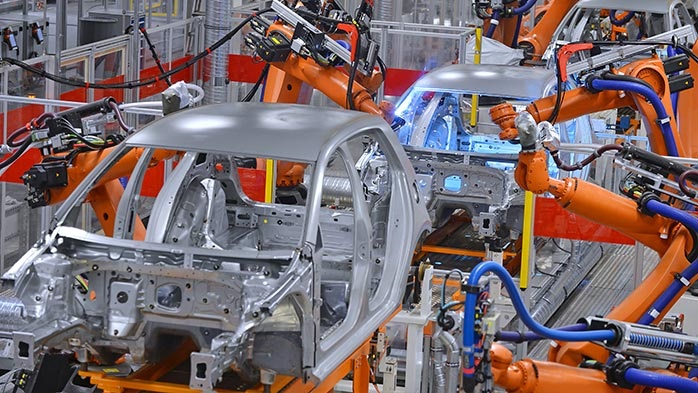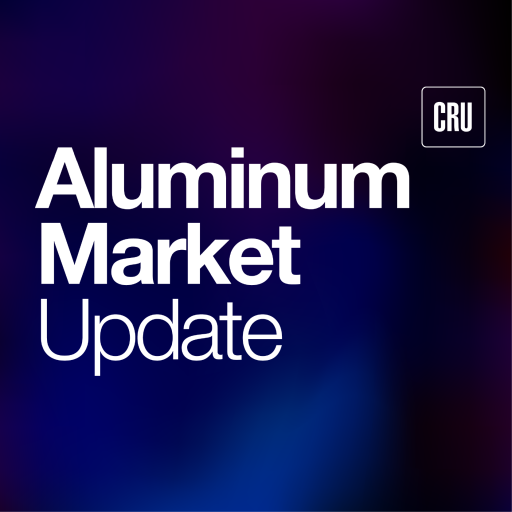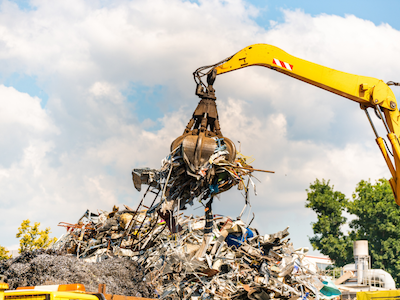Decarbonization

August 4, 2025
Second-quarter breakdown: Tracking divergence in automotive aluminum
Written by Nicholas Bell
Aluminum producers with exposure to the automotive market reported an almost unanimous weak second quarter in terms of shipment volumes.
Three companies – Constellium, Kaiser, and Granges – each posted year-over-year declines across at least one major automotive product segment. Norsk Hydro reported a slight increase in total North American extrusion shipments, a figure that includes but does not delineate automotive extrusions specifically.
Uneven Q2 shipments
At Constellium, year-over-year automotive rolled product shipments dropped 8% to 295,000 metric tons (mt) in the latest quarter, and extruded product shipments ticked down less than 1% to 249,000 mt.
Kaiser’s second quarter shipments of automotive extrusions fell to 14%-15% to 24,000 mt from the prior year period, the steepest declined of the group and a reflection of its heavier concentration in structural applications tied to U.S. assembly schedules.
Granges, which supplies rolled aluminum primarily for automotive heat exchangers, reported a 13% year-over-year drop in tonnage to 7,000 mt.
Norsk Hydro was the exception, reporting a 1% increase in North American extrusion volumes at 107,000 mt, noting increased deliveries to key automotive companies. The comment on the gain in automotive shipments is folded into a category that includes industrial, building, and general transportation end markets makes it difficult to interpret as a meaningful countersignal, especially without a hard number for the increase in deliveries to automotive customers.
Safety, structural, and neither
For those keeping score, that’s two sharp drops in automotive rolled products, as well as one sharp drop, one very slight dip, and one marginal uptick in automotive aluminum or just aluminum extrusions. Barring any company-specific or contractual details, there’s little at first glance to thread them together.
The nature of the product and its place in the value chain can illuminate the variations in deliveries across the four companies in North America.
In both strong and weak markets, safety typically takes precedence when assembling vehicles. Automakers are reluctant to risk disruption or regulatory non-compliance by substituting or changing their supplier of safety components.
Conversely, non-safety parts are often more flexible when it comes vehicle composition and react more dynamically to inventory overhang, waning backlogs, and production delays. These parts may be more subject to quick pullbacks when inventory is seen to be ahead of the market.
In a down market, the latter are the first to show softness.
This begins to explain why Kaiser saw such a steep drop in extrusion shipments: Much of what it sells in North America goes into drivetrain-related components and manifold blocks.
Hydro, presumably the one company to report gains in automotive aluminum shipments in North America so far, manufactures crash management systems. The company produces other products as well, but these systems are a major selling point of their extrusion plants in North America.
Similarly, Constellium’s extrusion portfolio consists of crash rails, impact beams, and rocker panels, which are also important structural components for safety.
A possible explanation for why Constelllium registered a -0.4% drop compared to Hydro’s extrusion 1% uptick is that Constellium’s extruded products do seem to complement, rather than constitute, complete crash systems, and that fragmentation may have exposed it to a little more variability in demand. Realistically, the discrepancy is probably within a range considered operationally insignificant. This class of automotive components tends to be platform-specific.
If an engineered extrusion is safety-critical and it’s been qualified through crash testing and certification, it’s locked into the model’s design. Any substitution would need to go through another round of greater-than-average scrutiny than a non-safety component, especially if its not a non-safety structural component.
Tier exposure
So, why did Kaiser post such a sharp dip in extruded product shipments?
The difference doesn’t just lie in the safety-critical vs. non-safety-critical component variability, but to where these products and their buyers sit in the value chain.
The extrusion product types Kaiser manufactures and sells in North America would lean toward customers that are a couple of steps removed from the final assembly process.
The buyers would likely be Tier 2 supplier to an original equipment manufacturer (OEM), or even Tier 3 supplier, which in this case the end OEM would be a Ford, General Motors, or Stellantis assembly plant, for example. Additionally, the products aren’t typically safety-critical in a lot of circumstances.
So, while weak demand for non-safety products seems to be a result of demand elasticity, a tier of buyers might have otherwise had counterbalancing effect in terms of immediate impact.
On the other hand, safety and structural extrusions like the ones shipped by Constellium and Norsk Hydro are often intended for shipment to OEM’s or, more likely, sub-assembly Tier 1 suppliers.
Now, this differentiation presents a dilemma because, typically OEM’s and Tier 1 suppliers are the first to experience call-offs in a down market, while the Tier 2 and 3 suppliers experience a lagged impact.
That distinction helps contextualize why Constellium logged a sharp drop in automotive rolled products.
Constellium produces flat-rolled products for safety/structural applications to be sure, but they also produce “inners” and “outers” body panels. It’s a broad category, but one in which “hang-on” parts would fall under, which was discussed during a presentation at AMU’s PATH event earlier this year.
Hang-on parts, like these inner/outer body panels and trims, are non-load-bearing panels attached to a vehicle’s body that can easily be swapped for steel parts. Their use of aluminum content is meant to lighten the vehicle, but for cost control purposes they can be replaced without triggering the need for full-vehicle CO2 re-certification.
They’re also parts that are shipped to OEM’s and Tier 1 suppliers – and highly sensitive to build rates and the quickest to be called-off without risking a serious safety flaw in auto manufacture’s vehicle platforms.
Hence, the intracompany divergence between Constellium’s barely softer automotive extrusion shipments and its’ 8% drop in automotive rolled products.
Because of their position in the value chain and OEM-proximity, these products were likely hit more directly by the recent downward revision in automotive sector demand and the resulting production pullbacks.
Thermal management and the EV cooldown
With that segue, the final company to examine – one that produces flat-rolled products for non-safety, non-structural components and sells primarily to Tier 1 suppliers – also posted one of the sharpest shipment declines of the group, though with a significant extenuating caveat worth noting.
Granges produces flat-rolled products to be used by thermal management system manufacturers in the automotive market.
Thermal management systems occupy a niche market, and its dynamics are often opaque except to domain specialists, but a few broader assumptions are worth exploring.
Engineered extrusions used in structural systems typically have longer lead times due to their specialized, vehicle-specific nature. By contrast, thermal management materials, though also niche, are sold in the form of flat-rolled products like foil/fin stock and tubular products, which, while not commoditized in alloy or application, are more standardized in product form and not tailored to a single make or model.
What complicates demand visibility is the layered supply chain: Whether Granges is selling to Tier 1 thermal system integrators or into Tier 2 and Tier 3 suppliers, its exposure to production slowdowns differs from companies in the structural extrusion (or even flat-rolled) aluminum market.
Aluminum used in thermal management has tapped into a demand segment in the form of electric and hybrid vehicles with products like battery cooling plates and electronics enclosures. Granges has sought long-term opportunity in the segment, which has been facing a transitional slowdown that’s both immediate and cumulative.
The electric and hybrid vehicle segment is contending not only with a deceleration in EV production but also the effects of a broader downturn that’s played out over a couple of quarters now. This means that whether they sell to Tier 1, 2, or 3 suppliers, the impact is felt upstream across an entire subsector for these products.
Big rigs and big drops
Further adding to the drag, thermal systems are more aluminum-intensive in commercial vehicles, not necessarily as a share of the vehicle’s total aluminum content, but in terms of sheer volume due to vehicle size and system mass.
Applications for reefers, or refrigerated trucks/vans/trailers, amplify this effect, and as we’ve reported in a recent analysis, those vehicle categories have seen some of the steepest declines of any vehicle segment.
In fact, while Granges doesn’t break out their products into a transportation end sector in their earnings, Norsk Hydro does distinguish between transportation and automotive, under which their commercial vehicle sales are tabulated.
Of the companies surveyed, Hydro was the only one to report a shipment increase in North America. Notably, the company was also the only one to flag trends in the commercial vehicle segment. Management cited soft demand in the transportation end market as one of the two key segment-specific reasons for its downgraded extrusion outlook for the second half of the year, the other being automotive.
Conclusion: Temporary to transitioned
The data from the second quarter paints a picture of a disjointed automotive aluminum market, uniformly flat-to-lower, but not across all forms and product types or OEM proximity.
Engineered extrusions tied to crash performance and structural integrity appear more insulated due to their integral place in safety systems and the regulatory scrutiny required to qualify substitutes.
Conversely, commodity-like flat-rolled products tied to hang-on parts, and more specifically thermal management systems in Granges’ case, are proving more vulnerable, particularly when sold into Tier 1 or integrated OEMs sensitive to build rate shifts.
Nevertheless, relatively speaking the automotive sector was flat-to-lower from the start and end of the value chain, and across multiple products forms, and it’s clear that North American auto production has regressed past the initial stages of pullback and into a new stage of recalibration.







